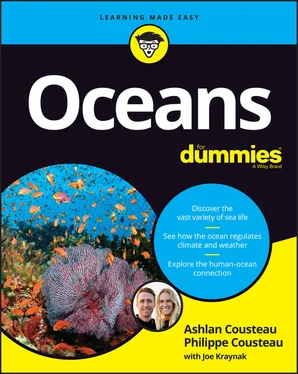 Some people used to think that the ocean was too big to fix, but as former NOAA director Jane Lubchenco says, “It’s time to stop thinking of the ocean as a victim of climate change and start thinking of it as a powerful part of the solution.” Here are some of the ways the ocean can help reduce global warming:
Some people used to think that the ocean was too big to fix, but as former NOAA director Jane Lubchenco says, “It’s time to stop thinking of the ocean as a victim of climate change and start thinking of it as a powerful part of the solution.” Here are some of the ways the ocean can help reduce global warming:
The ocean can serve as a power source to reduce our reliance on fossil fuels. People are already harvesting energy from wind, waves, and tides. The ocean is also the largest collector of solar energy, and through ocean thermal energy conversion (OTEC) and other technologies, people are using that heat to produce electricity. (See Chapter 19for more about tapping the ocean for energy.)
The ocean is the biggest heat sink and carbon sink on the planet, meaning the ocean absorbs a huge amount of the heat and carbon before they significantly impact life on Earth. If we maintain and in some cases restore a healthy blue carbon ecosystem, the ocean can continue to sequester and store carbon, doing much of the heavy lifting required to reduce carbon in the atmosphere.
Sustainable aquaculture (land-based aquatic farming) and mariculture (ocean-based aquatic farming) of both marine plants and animals can help grow food, establish new habitats create new jobs, and absorb some extra carbon as well.
The good news is that by working together in partnership with the ocean, there is the very real possibility that we can stop the downward spiral we have set ourselves upon, restore the ocean to abundance, and rebuild a thriving future for all living creatures both above and below the ocean’s surface.
Part 2
IN THIS PART …
Explore different ways to divide the ocean into zones based on depth, light, distance from shore, and other factors … and understand why we divide the ocean into zones.
Grasp the concept of marine ecosystems — biological “neighborhoods” where organisms have evolved over time in response to their interactions with their environment and with one another. (Well, now you’ve grasped it.)
Visit the most popular ocean ecosystems from mudflats, estuaries, and mangrove forests along the coasts to offshore kelp beds and coral reefs to ecosystems that form around hydrothermal vents and cold seeps in the deep ocean.
Explore the geophysics of the ocean — the contours of the ocean floor, how it was shaped over time, what’s on and below the seafloor … those sorts of things.
Chapter 4
Mapping the Ocean by Zones
IN THIS CHAPTER
 Slicing and dicing the ocean into different zones
Slicing and dicing the ocean into different zones
 Navigating horizontal zones from coast to open sea
Navigating horizontal zones from coast to open sea
 Plumbing the depths of vertical zones from surface to seafloor
Plumbing the depths of vertical zones from surface to seafloor
 Checking out other zone concepts and terms
Checking out other zone concepts and terms
People like to divide really big things into smaller parts to better understand, discuss, and manage them. For instance, your city or town probably has residential, commercial, and maybe even industrial and agricultural zones. Meteorologists divide the world into climate zones — tropical, temperate, arid, continental, and polar. To deliver mail more efficiently, the U.S. Postal Service breaks down the entire country into postal zones, each with its own ZIP code.
Likewise, oceanographers divide the ocean into several zones to better understand the conditions required for different organisms and ecosystems to evolve and exist. They use several criteria to designate a zone, including exposure to tides and currents, the area’s topography (physical characteristics), depth, amount of light, and more.
In this chapter, we lead you on an exploration of the different ocean zones. Understanding these zones will enhance your understanding of the ocean and its fascinating habitats and inhabitants … assuming you don’t zone out while reading this chapter (sorry, we couldn’t resist).
Dividing the Ocean into Three Horizontal Zones
The ocean’s horizontal zones extend from shoreline to the deep blue sea and are generally classified as shallow, deep, and deeper or, more scientifically, as intertidal, neritic, and oceanic (see Figure 4-1). In this section, we describe each zone, the conditions that make each one special, and some of the more interesting inhabitants that call them home.

©John Wiley & Sons, Inc.
FIGURE 4-1:The ocean’s horizontal zones.
 Mobile animals, such as crabs and sea stars, can move between zones to find optimal locations at different times of day, and can even take refuge in wet rock crevices if conditions get too hot and dry.
Mobile animals, such as crabs and sea stars, can move between zones to find optimal locations at different times of day, and can even take refuge in wet rock crevices if conditions get too hot and dry.
Where land meets sea: The intertidal zone
Time to dip our toes into the ocean, literally, because if your toes ARE close to shore, you’re in the intertidal zone (also known as the littoral zone ) — the area along the coastline that’s underwater at high tide and exposed at low tide. Depending on where on the coast you’re standing, the intertidal zone can look drastically different. You could be looking at a sandy beach, a mudflat, a rocky shoreline, a marsh, or a mangrove forest, for example.
The intertidal zone can be further divided into low, middle, and high regions, based on how far up from the ocean it is, which generally determines how wet it gets and therefore the nature of the marine life you’re likely to bump into. Some rocky intertidal zones contain rock pools, which are important sources of water when the tide recedes.
So who, or what, lives in the intertidal zone? Well that really depends on the region and variations in topography (for example, sand, rock, grass, mangroves, ice). We get into that more in Chapter 5. For now, let’s look at the three regions of the intertidal zone.
If you’re standing on the coast and feeling as though someone left you high and dry, you’re in the high intertidal region. Here, creatures are adapted to eke out a more terrestrial existence. Because the high intertidal region doesn’t get a lot of wave action, its inhabitants need to be better equipped to survive heat, sun, lack of moisture, and saltier water. (Water becomes saltier as it evaporates, leaving the salt behind.)
Common critters found higher in the intertidal zone are invertebrates that are better adapted to resist desiccation (drying out), such as snails, limpets, barnacles, and other animals with shells. Some of these animals store seawater in their shells to prevent them from drying out, sort of like carrying around their own reusable water bottles.
One step down from the high intertidal region is the middle intertidal region — home to anemones, chitons, and mussels, which feed underwater, yet have some degree of evolutionary adaptation to survive hot and dry spells. Sea stars and crabs may also wander up to this region for a visit.
Читать дальше

 Some people used to think that the ocean was too big to fix, but as former NOAA director Jane Lubchenco says, “It’s time to stop thinking of the ocean as a victim of climate change and start thinking of it as a powerful part of the solution.” Here are some of the ways the ocean can help reduce global warming:
Some people used to think that the ocean was too big to fix, but as former NOAA director Jane Lubchenco says, “It’s time to stop thinking of the ocean as a victim of climate change and start thinking of it as a powerful part of the solution.” Here are some of the ways the ocean can help reduce global warming: Slicing and dicing the ocean into different zones
Slicing and dicing the ocean into different zones
 Mobile animals, such as crabs and sea stars, can move between zones to find optimal locations at different times of day, and can even take refuge in wet rock crevices if conditions get too hot and dry.
Mobile animals, such as crabs and sea stars, can move between zones to find optimal locations at different times of day, and can even take refuge in wet rock crevices if conditions get too hot and dry.










